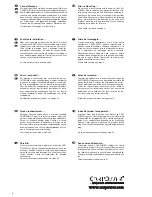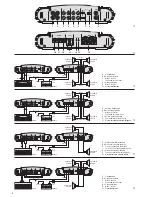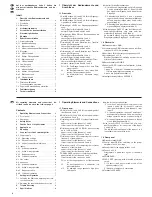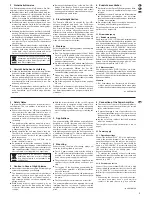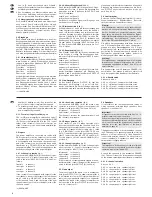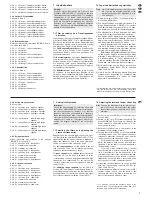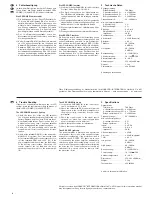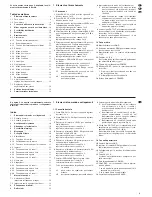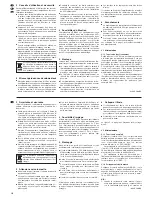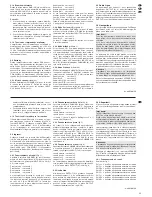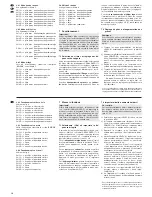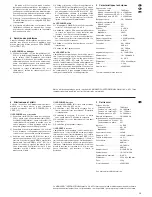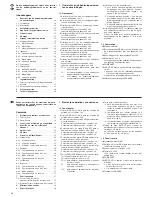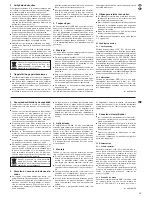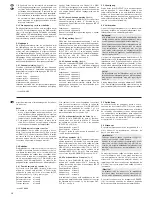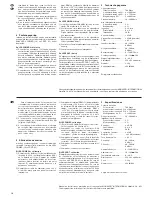
Auf der ausklappbaren Seite 3 finden Sie
alle beschriebenen
Bedien elemente und An
-
schlüsse.
Inhalt
1
Übersicht der Bedienelemente und
Anschlüsse
. . . . . . . . . . . . . . . . . . . . . . . . . 4
1.1 Frontseite . . . . . . . . . . . . . . . . . . . . . . . . . . . 4
1.2 Rückseite . . . . . . . . . . . . . . . . . . . . . . . . . . . 4
2
Sicherheitshinweise
. . . . . . . . . . . . . . . . . . 5
3
Vorsicht bei hohen Lautstärken
. . . . . . . . 5
4
Einsatzmöglichkeiten
. . . . . . . . . . . . . . . . . 5
5
Montage
. . . . . . . . . . . . . . . . . . . . . . . . . . . . 5
6
Endstufe anschließen
. . . . . . . . . . . . . . . . 5
6.1 Stromversorgung . . . . . . . . . . . . . . . . . . . . . 5
6.1.1
Betriebsspannung . . . . . . . . . . . . . . . . . . . 5
6.1.2
Masseanschluss . . . . . . . . . . . . . . . . . . . . 5
6.1.3
Steuerspannung zum Einschalten . . . . . . 6
6.2 Eingänge . . . . . . . . . . . . . . . . . . . . . . . . . . . 6
6.2.1
4-Kanalbetrieb . . . . . . . . . . . . . . . . . . . . . . 6
6.2.2
Aktiver 2-Wegebetrieb . . . . . . . . . . . . . . . . 6
6.2.3
Brückenbetrieb . . . . . . . . . . . . . . . . . . . . . 6
6.2.4
3-Kanalbetrieb . . . . . . . . . . . . . . . . . . . . . . 6
6.3 Line-Ausgang . . . . . . . . . . . . . . . . . . . . . . . . 6
6.4 Lautsprecher . . . . . . . . . . . . . . . . . . . . . . . . . 6
6.4.1
4-Kanalbetrieb . . . . . . . . . . . . . . . . . . . . . . 6
6.4.2
Aktiver 2-Wegebetrieb . . . . . . . . . . . . . . . . 7
6.4.3
Brückenbetrieb . . . . . . . . . . . . . . . . . . . . . 7
6.4.4
3-Kanalbetrieb . . . . . . . . . . . . . . . . . . . . . . 7
7
Inbetriebnahme
. . . . . . . . . . . . . . . . . . . . . . 7
7.1 Filter auswählen und
Trennfrequenzen einstellen . . . . . . . . . . . . . 7
7.2 Pegel und Bassanhebung einstellen . . . . . . 7
8
Fehlerbeseitigung
. . . . . . . . . . . . . . . . . . . . 8
9
Technische Daten
. . . . . . . . . . . . . . . . . . . . 8
1
Übersicht der Bedienelemente und
Anschlüsse
1.1 Frontseite
1
Cinch-Buchsen CH 1 und CH 2 für die Eingangs-
signale der Kanäle 1 und 2
2
Cinch-Buchsen CH 3 und CH 4 für die Eingangs-
signale der Kanäle 3 und 4
3
Trimmregler LEVEL zur Eingangspegelanpas-
sung:
oberer Regler für die Kanäle 1 und 2,
unterer Regler für die Kanäle 3 und 4
4
Trimmregler BASS EQ zur Bass
anhebung bis
12 dB bei 50 Hz:
oberer Regler für die Kanäle 1 und 2,
unterer Regler für die Kanäle 3 und 4
5
Trimmregler HP zum Einstellen der Trenn
fre -
quenz des Hochpasses:
oberer Regler für die Kanäle 1 und 2,
unterer Regler für die Kanäle 3 und 4
6
Trimmregler LP zum Einstellen der Trennfre-
quenz des Tiefpasses:
oberer Regler für die Kanäle 1 und 2,
unterer Regler für die Kanäle 3 und 4
7
Schalter CROSSOVER zur Auswahl der Filter:
oberer Schalter für die Kanäle 1 und 2,
unterer Schalter für die Kanäle 3 und 4
FULL für Full-Range-Lautsprecher, kein Filter
eingeschaltet
LP
für Basslautsprecher oder einen
Sub -
woofer, Tiefpass eingeschaltet
HP
für Mittelhochtöner, Hochpass einge-
schaltet
8
Schalter für den Betriebsmodus
„2“ für aktiven 2-Wegebetrieb: nur die Eingänge
3 und 4 anschließen (Abb. 4), Kanal 1 er hält
das Signal vom Eingang 3 und Ka nal 2 vom
Eingang 4
„3“ 3-Kanalbetrieb: Kanäle 1 und 2 arbeiten
separat, Kanäle 3 und 4 werden im Brücken-
betrieb zum Antreiben eines Sub
woofers
genutzt (Abb. 6)
„4“ 4-Kanalbetrieb: jeder Kanal wird über einen
eigenen Eingang angesteuert (Abb. 3)
9
Line-Ausgänge OUTPUT zum Anschluss eines
Subwoofer-Verstärkers oder auch zum An
-
schluss der Eingänge 3 und 4 (Abb. 6)
An beiden Buchsen liegt das durchgeschleifte
Eingangssignal der Eingänge 1 – 4 in Mono an.
1.2 Rückseite
10
Masseanschluss GND
11
Steuereingang REM zum Einschalten der End-
stufe über eine 12-V-Spannung
12
Anschluss für die Versorgungssp12 V
13
Sicherungen 2 × 25 A
Eine durchgebrannte Sicherung nur durch eine
gleichen Typs ersetzen!
14
Betriebsanzeige POWER
15
Anzeige PROT. leuchtet bei aktivierter Schutz-
schaltung:
1. wenn an einem der Lautsprecherausgänge
(16) ein Kurzschluss aufgetreten ist
2. wenn die Endstufe überhitzt ist
16
Lautsprecheranschlüsse SPEAKER
All operating elements and connections
de -
scribed can be found on the fold-out page 3.
Contents
1
Operating Elements and Connections
. . . 4
1.1 Front panel . . . . . . . . . . . . . . . . . . . . . . . . . . 4
1.2 Rear panel . . . . . . . . . . . . . . . . . . . . . . . . . . 4
2
Safety Notes
. . . . . . . . . . . . . . . . . . . . . . . . 5
3
Caution Case of High Volumes
. . . . . . . . . 5
4
Applications
. . . . . . . . . . . . . . . . . . . . . . . . 5
5
Mounting
. . . . . . . . . . . . . . . . . . . . . . . . . . . 5
6
Connection of the Power Amplifier
. . . . . . 5
6.1 Power supply . . . . . . . . . . . . . . . . . . . . . . . . 5
6.1.1
Operating voltage . . . . . . . . . . . . . . . . . . . 5
6.1.2
Ground connection . . . . . . . . . . . . . . . . . . 5
6.1.3
Control voltage for switching-on . . . . . . . . 6
6.2 Inputs . . . . . . . . . . . . . . . . . . . . . . . . . . . . . . 6
6.2.1
4-channel operation . . . . . . . . . . . . . . . . . 6
6.2.2
Active 2-way operation . . . . . . . . . . . . . . . 6
6.2.3
Bridge operation . . . . . . . . . . . . . . . . . . . . 6
6.2.4
3-channel operation . . . . . . . . . . . . . . . . . 6
6.3 Line output . . . . . . . . . . . . . . . . . . . . . . . . . . 6
6.4 Speakers . . . . . . . . . . . . . . . . . . . . . . . . . . . 6
6.4.1
4-channel operation . . . . . . . . . . . . . . . . . 6
6.4.2
Active 2-way operation . . . . . . . . . . . . . . . 7
6.4.3
Bridge operation . . . . . . . . . . . . . . . . . . . . 7
6.4.4
3-channel operation . . . . . . . . . . . . . . . . . 7
7
Setting into Operation
. . . . . . . . . . . . . . . . 7
7.1 Selecting the filters and adjusting the cross -
over frequencies . . . . . . . . . . . . . . . . . . . . . . 7
7.2 Adjusting the level and the bass boosting . . 7
8
Trouble Shooting
. . . . . . . . . . . . . . . . . . . . 8
9
Specifications
. . . . . . . . . . . . . . . . . . . . . . . 8
1
Operating Elements and Connections
1.1 Front panel
1
RCA jacks CH 1 and CH 2 for the input signals of
the channels 1 and 2
2
RCA jacks CH 3 and CH 4 for the input signals of
the channels 3 and 4
3
Trimming controls LEVEL for input level match-
ing:
upper control for the channels 1 and 2,
lower control for the channels 3 and 4
4
Trimming controls BASS EQ for bass boosting
up to 12 dB at 50 Hz:
upper control for the channels 1 and 2,
lower control for the channels 3 and 4
5
Trimming controls HP for adjusting the crossover
frequency of the high pass:
upper control for the channels 1 and 2,
lower control for the channels 3 and 4
6
Trimming controls LP for adjusting the crossover
frequency of the low pass:
upper control for the channels 1 and 2,
lower control for the channels 3 and 4
7
CROSSOVER switches for selecting the filters:
upper switch for the channels 1 and 2,
lower switch for the channels 3 and 4
FULL for full range speakers, no filter switched
on
LP
for bass speakers or a subwoofer, low
pass switched on
HP
for mid-high range speakers, high pass
switched on
8
Switch for the operating mode
“2” for active 2-way operation: only connect the
in puts 3 and 4 (fig. 4), channel 1 receives
the si gnal from input 3 and channel 2 from
in put 4
“3” 3-channel operation: channels 1 and 2 oper-
ate sepa rately, channels 3 and 4 are used in
bridge operation to drive a subwoofer (fig. 6)
“4” 4-channel operation: each channel is driven
via an individual input (fig. 3)
9
Line jacks OUTPUT for connection of a sub-
woofer amplifier or for connection of the inputs
3 and 4 (fig. 6)
The fed-through input signal of the inputs 1 to 4
is available in mono at both jacks.
1.2 Rear panel
10
Ground terminal GND
11
Control input REM for switching on the power
amplifier via a 12 V voltage
12
Connection for the supply v12 V
13
Fuses 2 × 25 A
Only replace a blown fuse by one of the same
type!
14
POWER LED
15
LED PROT. lights up with activated protective
circuit:
1. if a short circuit has occurred at one of the
speaker outputs (16)
2. if the power amplifier is overheated
16
Terminals SPEAKER
4
GB
D
A
CH


